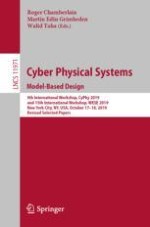2020 | Book
Cyber Physical Systems. Model-Based Design
9th International Workshop, CyPhy 2019, and 15th International Workshop, WESE 2019, New York City, NY, USA, October 17-18, 2019, Revised Selected Papers
Editors: Roger Chamberlain, Martin Edin Grimheden, Walid Taha
Publisher: Springer International Publishing
Book Series : Lecture Notes in Computer Science
